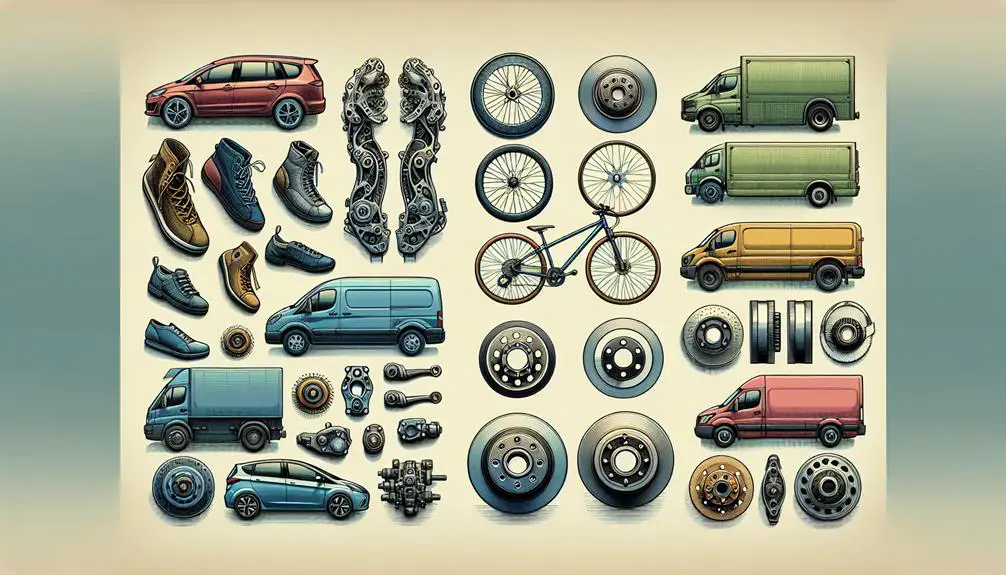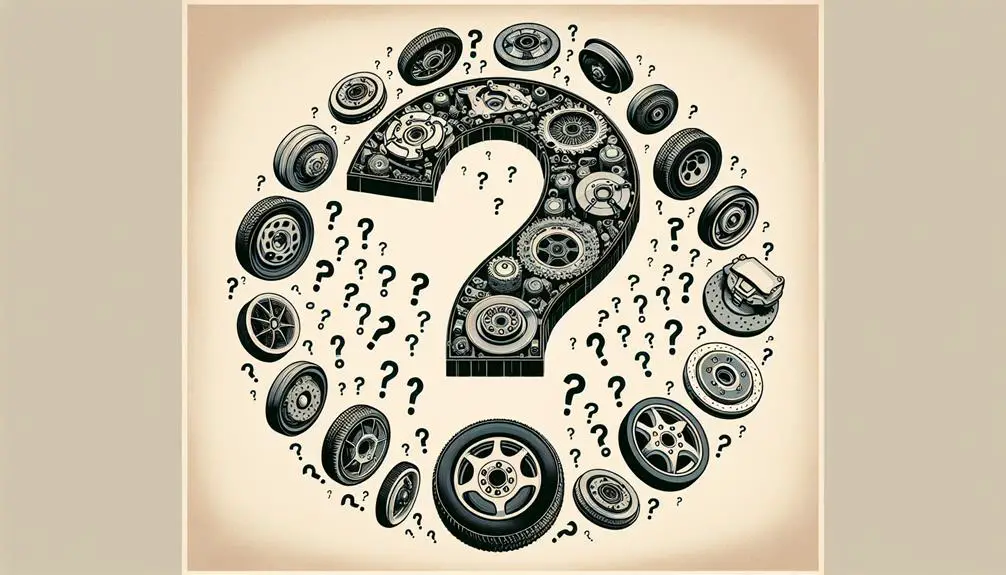Brake shoes are not universal.
Variability across models and the factors affecting compatibility are not always straightforward.
As we investigate the subtleties, from design differences to material composition, you'll see why a one-size-fits-all approach may not be the best stance.
Stick around to uncover tips for selecting the right brake shoes and dispel common misconceptions that could impact your decision-making process.
Understanding Brake Shoes

Brake shoes play an essential role in your vehicle's braking system, directly impacting its safety and performance. They're the components that, when you press the brake pedal, press against the inside of a drum brake, creating friction to slow down or stop your vehicle. It's vital you understand their functionality to maintain your vehicle properly.
Each brake shoe is fitted with a high-friction material on one side, which wears down over time because of the constant contact and friction created during braking. This means they're a part of your vehicle that you'll need to replace periodically to make sure your brakes remain effective. Not paying attention to their condition can lead to decreased braking efficiency or, in the worst-case scenario, brake failure.
You might wonder about the materials used in brake shoes. They're typically made from a composite material, including metals like steel for the backing, and a friction material that can vary in composition. The specific materials used are chosen for their ability to provide reliable braking power and durability under the stress of repeated use. Keeping them in good condition isn't just about maintaining performance but making sure your safety on the road.
Variability Across Models
Exploring the functionality and composition of brake shoes sets the stage for delving into how their design and compatibility can vary greatly across different vehicle models. You've learned that brake shoes play a critical role in stopping your vehicle, but here's where it gets tricky: not all brake shoes are created equal. The differences aren't just minor details; they're significant enough to affect which brake shoes you can use with your vehicle.
The variability across models stems from several key factors:
- Size and Shape: Just like shoes that fit your feet, brake shoes need to fit the specific dimensions and contours of your vehicle's wheel drum.
- Material Composition: Different vehicles demand brake shoes made from materials that match their performance requirements, whether it's for standard commuting or heavy-duty tasks.
- Brand Specifications: Some manufacturers design their vehicles to work best with proprietary brake shoe designs, limiting your options to specific brands.
- Year of Manufacture: Older models might require brake shoes that are no longer in production, making it a challenge to find compatible replacements.
Understanding this variability helps you grasp why finding the right brake shoes isn't as straightforward as you might've hoped.
Factors Affecting Compatibility

Why then, do certain brake shoes fit your vehicle while others don't?
The answer lies in a few key factors that determine compatibility. First off, the make and model of your car play a pivotal role. Manufacturers design brake systems tailored to the specifications of each model, including dimensions and materials, which means not all brake shoes will match your vehicle's requirements.
Then there's the year of manufacture. Car models undergo updates and facelifts over the years, often leading to changes in brake system components. A brake shoe that fits a 2010 model mightn't be right for a 2020 version of the same car.
Wheel size also factors in. Vehicles with larger wheels may require larger brake shoes to ensure sufficient braking force. It's not just about the outer dimensions; the shape of the brake shoe must align with the drum's interior contour for proper engagement.
Lastly, driving conditions and preferences can influence compatibility. If you frequently drive in harsh conditions or prioritize performance, you'll need brake shoes designed for higher durability or enhanced friction properties, which mightn't be universal.
Comprehending these factors guarantees you don't waste time and resources on incompatible brake shoes.
Tips for Selecting Brake Shoes
Exploring the factors that influence brake shoe compatibility, let's now examine how to select the appropriate ones for your vehicle. Choosing the right brake shoes is important for ensuring safety and peak performance. Here are some tips to guide you through the process:
- Check your vehicle's manual: Your car's manual contains specific recommendations from the manufacturer regarding the type and size of brake shoes best suited for your model. It's the primary place you should look.
- Consider your driving conditions: If you often drive in challenging conditions, like mountainous terrains or frequently haul heavy loads, opt for brake shoes designed for high performance and durability.
- Look for compatibility: Make sure that the brake shoes you're considering are compatible with your vehicle's make, model, and year. This ensures they'll fit perfectly and function as intended.
- Read reviews and get recommendations: Look at reviews from other users who've the same vehicle model as yours. Recommendations from trusted mechanics or automotive forums can also provide valuable insights into the best brake shoes for your needs.
Common Misconceptions

One common misconception is that all brake shoes are interchangeable across different vehicle models. This couldn't be further from the truth. Each vehicle has its own set of specifications for brake shoes, including size, material, and design. Thinking you can just grab any pair off the shelf and they'll fit is a mistake that can compromise your car's braking performance, or worse, lead to brake failure.
Another widespread myth is that more expensive brake shoes automatically mean better quality and longer life. While it's true that premium materials can offer better performance and durability, it doesn't mean you should overlook less expensive options. Some budget-friendly brake shoes might very well meet or even exceed your vehicle's specifications. It's all about finding the right balance between quality and price that suits your needs and your vehicle's requirements.
Lastly, there's the belief that installing new brake shoes is a universal, one-size-fits-all process. In reality, the installation process can vary significantly between different types of vehicles and brake systems. It's important to follow the specific guidelines for your vehicle to guarantee proper installation and best brake performance.
Conclusion
To sum up, you've seen that brake shoes aren't one-size-fits-all. The variety across models and the factors affecting compatibility mean you've got to be diligent in your selection. Remember, not all brake shoes will fit your vehicle, and assuming otherwise can lead to mistakes.
Follow the tips provided, steer clear of common misconceptions, and you'll find the perfect match for your car. It's all about grasping your vehicle's needs and making an informed choice.